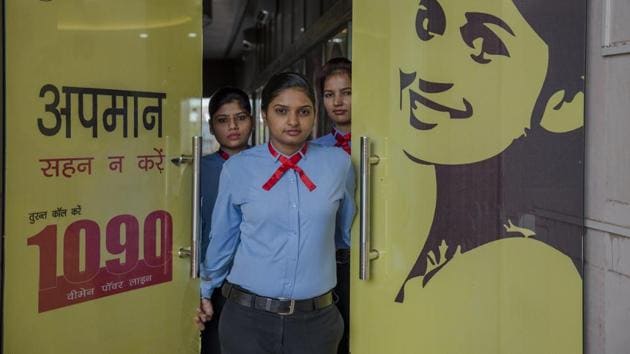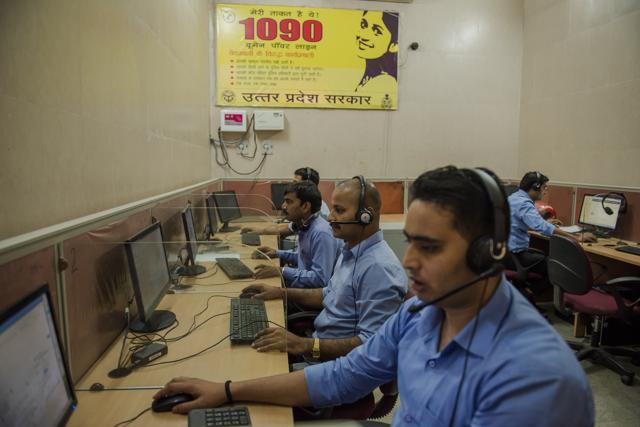1090 helpline: When stalkers call women in UP, it’s the cops who call them back
A day at 1090, a helpline where constables crack down on stalking and abuse, call-centre style.
Rajesh Pratap Yadav, a constable with the Uttar Pradesh police, has spent the past four years working at a call centre: glowering at a computer screen and grunting into a mouthpiece. Yadav makes around 100 phone calls every day. He begins each with the same line: “I am police officer Rajesh Pratap Yadav calling from Woman Power Line. A woman has made a complaint that you have harassed her on the phone.”

Yadav is one of 40 constables who make up the male half of ‘Woman Power Line’, the Uttar Pradesh police’s 24/7 phone line for women in trouble. Launched in October 2012, the call centre, housed in a circular tower in the centre of Lucknow, was supposed to fix common women’s problems — “eve-teasing”, stalking, phone-related abuse — not covered under any existing law.
“This is before the case of Nirbhaya gang rape in Delhi and the subsequent amendment to criminal law,” says inspector general Navniet Sekera who designed the phone-in system. Sekera describes himself as a “trigger-happy” cop who had to teach himself to think like a woman to come up with 1090. In 2012, following a young woman’s breakdown at a public meeting called by Akhilesh Yadav, Sekera was called over and put in charge of women’s issues. Four years on, 1090 — “dus nabbe” as everyone calls it in UP — is a phenomenon in the state. The large hoardings in Lucknow helped; so did awareness camps in the smallest of villages.
Read | Mobile numbers of girls for sale in UP recharge shops
Within a year of its inauguration, though, everyone at 1090 knew what they were going to deal with most of their time. Ninety per cent of the 661,129 calls women made to 1090 between 2012 and 2016 were to complain about phone harassment. The calls are received by a set of 40 young women — a mix of college students and constables — who are the face of 1090. The call details are then passed over to Rajesh Pratap Yadav and his colleagues for the second stage of the 1090 routine: calling the numbers reported for abuse. In Uttar Pradesh, as Sekera puts it, it’s best to let men deal with men.
Yadav dresses like an average call centre operator: well-fitting blue shirt, crisp black trousers, black-rimmed glasses, a pen in left pocket, a dress watch on the wrist, and big black headphones around his head. But once he’s speaking into his mouthpiece, Yadav is pure menace. The tone is the sharpest when Yadav gets to the end of his opening monologue: “Maan jayiye, nahin mane toh karyavaahi ki jayegi. (Straighten up or we will be taking action).”

The men on the other side too have a line they like to open with: “I have no idea what you are talking about. I had put my phone to charge and gone to have a bath. Someone may have misused it in the meantime.” Some begin to cry right away. Some angle for sympathy. “They say ‘I like her’ or ‘she is my girlfriend who has stopped talking to me’,” says Yadav. Some claim that they dialled the number by mistake. And some simply say “sorry” and thank Yadav for “opening their eyes.” He has done the drill with tens of thousands over the years. “These are all kinds of men: young, old, teenagers, rural, urban, working, jobless.”
The schoolboy punishment
Most of them drop their game with one call from 1090. Some sit back only for a while before hitting the field again. “We track their numbers,” says Sekera. “If they harass a woman again, we move to the next level. We call the man in along with his parents, ask them to track his habit. We involve his sister if he happens to have one. We make them take an oath on Gita not to harass a woman again.” It turns out all it takes to straighten up “phone Romeos” in UP is the standard schoolboy punishment. Woman Power Line has solved 99 percent of the complaints using the combined might of parents, god, and an old-fashioned earful from a UP police constable.
Not every man buckles, though. Once every few months, Yadav is confronted with a man who refuses to do any of the following: listen to him, come over for a talk, or stop the calling spree. “Then we have to arrest them for phone stalking,” says Sekera. “We have arrested 600 in four years. All of them are over 50 years of age. Most of them are psychopaths.”
How do these men find the phone numbers of women? “These are men who keep dialling a series of numbers on their cell phones until they hear a woman’s voice on the other side. The moment they do, they start talking sleazy,” says Sekera. Or, he adds, they could buy phone numbers from a mobile recharge shop. The “recharge wale bhaiyya”, according to Sekera, has a register full of phone numbers, which he sells to men based on the looks of the girl whose number it is: “50 for average, 200 for beautiful.”
Read | Twitter reacts to HT’s story on sale of women’s phone numbers at UP’s recharge shops
“Anonymity is key to this system,” says Sekera. “Men usually buy these numbers using fake name and identification.”
No one knows how many recharge shops exist in UP. Enough of them, it may appear, to ensure a man doesn’t have to leave his neighbourhood to procure a woman’s phone number. “There are two-three recharge shops where we can get numbers of girls. There is one from where my friends and I buy a phone number for Rs 30,” says Mohammed, 24, from Shahjahanpur. “A father and a son alternately sit in the recharge shop. We go there when it’s the turn of the son.” Once he has the phone number, Mohammed would call a woman he has never met and coax her to accept his “friendship.”
The call centre is a good place to understand how streets have given way to smartphones as the prime location of everyday harassment women face in the heartland. It doesn’t always happen on a phone call. The wide-open field of Facebook and WhatsApp is just as likely a platform. “We get 10-15 calls about social media harassment every day,” says Sekera. “A man will create a profile using the face of a woman, befriend women and use their private information to blackmail them later. Ex-boyfriends will threaten to post intimate photos and videos on Facebook. Men will circulate the DP [display picture] of a woman on WhatsApp.” Or sometimes, as Mohammed and his friends are fond of doing in Shahjahanabad, “send vulgar pictures over WhatsApp.”

Women call 1090 to report other, more serious, issues too — physical stalking, domestic violence, dowry harassment. But most of these calls are forwarded to 100 for formal — and immediate — police action. Every once in a while, though, the 1090 operators are confronted with women calling to just talk about stuff : a husband they suspect of adultery, a mother-in-law they can’t stand, a crazy ex-boyfriend.
Like Yadav, Reema has already received over a 100 calls at her terminal. They have come from “everywhere in UP. Kanpur Dehat, Barabanki, Lucknow, Hardoi…” She’s worked at the Woman Power Line for a year now and spoken to about 200 women every day. A recent college graduate from Lucknow, Reema chose to work at the call centre because it sounded like a decent, well-paying job. “Also, once I used to get these calls on my phone,” she says. “I called 1090, which took care of the matter so I figured it would be nice to step in and help other women.”
Read | Meet Aparna Yadav, Mulayam’s younger daughter-in-law
The majority of women harassed on the phone are between the ages of 15 and 30, says Babita Singh, a police officer who runs the daily operation at 1090. Fifty percent of them are college students. Most women describe the phone harassment as “ulti-seedhi/faaltu baat”— a code word for the whole range of things a woman doesn’t expect to hear from a man she does not know: request for friendship, enquiry about her name and address, dirty talk, or abuse.

There are few situations the Woman Power Line isn’t prepared to handle, but things get crazy all the time. This evening is no different.
At 7:52 pm, the ‘stressometer’— a measure for the distress level of a call — on terminal 4 has hit red. A woman is calling from Rae Bareli to say that her ex-boyfriend won’t stop calling her. He is threatening to kill her. It’s a call that the operator will transfer to 100.
At 8:05 pm, the operator on terminal 6 is trying to explain to a man from Meerut that he has to allow his wife to come on the line and complain about the unsolicited calls on her mobile phone. It ends with the man hanging up cold.
“It’s a common problem,” says Babita Singh, “the men insist on talking on their wives’ behalf.” It’s less a problem in cities like Lucknow — one out of seven women in the city has called 1090 — than the interiors of UP. But things are changing fast, says Sekera. “The tolerance limit of women is going down. Earlier they would call if a man had been calling them for a month. Now they call 1090 within an hour of receiving such a call.”





